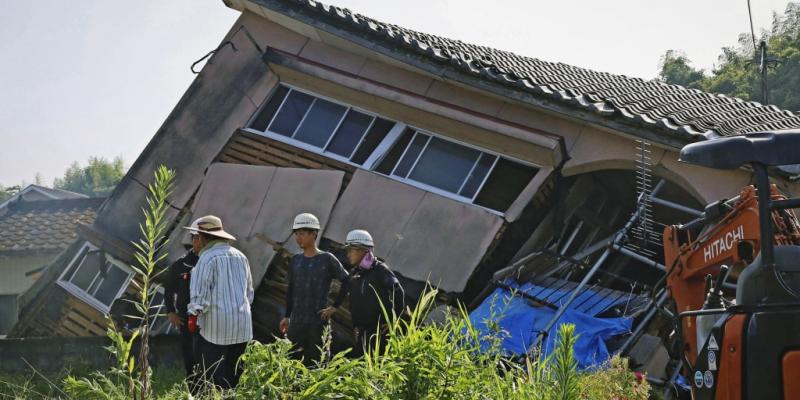Why Japan issued its first 'megaquake advisory,' and what that means



The Summary
- Japan's meteorological agency on Thursday issued its first-ever "megaquake advisory."
- The warning followed a 7.1-magnitude earthquake off the country's southern coast.
- That raises the risk of an even larger quake on the Nankai Trough, an underwater subduction zone that scientists believe is capable of producing temblors up to magnitude 9.1.
After a 7.1-magnitude earthquake shook southern islands in Japan on Thursday, the country's meteorological agency sent out an ominous warning: Another, larger earthquake could be coming, and the risk will be especially high over the next week.
In the first "megaquake advisory" it has ever issued, the agency said that the risk of strong shaking and a tsunami are greater than usual on the Nankai Trough, a subduction zone with the potential to produce magnitude 8 or 9 temblors. Area residents, it said, should prepare.
The message was not a prediction, but a forecast of enhanced risk — and it shows how far seismologists have come in understanding the dynamics of subduction zone earthquakes.
Here's what to know about the situation.
A dangerous subduction zone
The Nankai Trough is an underwater subduction zone where the Eurasian Plate collides with the Philippine Sea Plate, forcing the latter under the former and into the Earth's mantle.
Subduction zone faults build stress, and a so-called megathrust earthquake takes place when a locked fault slips and releases that stress. "Megaquake" is a shortened version of the name. These zones have produced the most powerful earthquakes in Earth's history.
The Pacific "Ring of Fire" is a collection of subduction zones. In the U.S., the Cascadia subduction zone off the West Coast runs from Vancouver Island, Canada, to Cape Mendocino, California.
The Nankai Trough fault has several segments, but if the entire margin of the fault were to slip at once, Japanese scientists believe the trough is capable of producing an earthquake of up to magnitude 9.1.
If a megaquake were to happen near Japan, the Philippine Sea Plate would lurch, perhaps as much as 30 to 100 feet, near the country's southeast coast, producing intense shaking.
The vertical displacement of the seafloor would cause a tsunami and push waves toward the coast of Japan. Those waves could reach nearly 100 feet in height, according to estimates from Japanese scientists published in 2020.
A history of big quakes
The Nankai Trough has produced large earthquakes roughly every 100 to 150 years, a study indicated last year. Japan's Earthquake Research Committee said in January 2022 said there was a 70% to 80% chance of a megathrust earthquake in the subsequent 30 years.
Large Nankai Trough earthquakes tend to come in pairs, with the second often rupturing in the subsequent two years. The most recent examples were "twin" earthquakes on the Nankai Trough in 1944 and 1946.
The phenomenon is due to the segmented nature of the fault; when one segment slips, it can stress another.
Thursday's magnitude-7.1 earthquake took place on or near the subduction zone, according to the United States Geological Survey.
Harold Tobin, a University of Washington professor who has studied the Nankai Trough, said the magnitude-7.1 quake took place in a segment that shakes more frequently than others. Regular earthquakes can relieve stress, so the possibility that the segment itself produces a big earthquake is less of a concern. The worry is the earthquake's proximity to a segment that's been building stress since the 1940s.
"It's adjacent to the western Nankai region and that's clearly locked up. That's the reason for alert and concern," Tobin said.
A forecast, not a prediction
Scientists can't predict earthquakes, but they are developing the ability to forecast times of heightened risk, particularly in areas with frequent shaking and good monitoring equipment, like Japan.
Firefighters walk near a fallen building in Wajima, in Japan's Ishikawa prefecture, after a New Year's Day earthquake.Kyodo News via AP
Japanese authorities are asking residents to prepare, review evacuation routes and pay attention to potential future warnings.
While the risk of a large quake is higher than usual, that doesn't mean it will happen anytime soon. Japanese government warning guidelines suggest that the chance a large earthquake follows a magnitude-7 within a week is roughly "once per a few hundred times," according to the study last year.
The most likely outcome is that the recent shaking won't trigger anything, even though the probability of a large earthquake is higher.
"We might wait decades before Nankai has another earthquake," Tobin said.
A known danger
In 2011, an area of the seafloor roughly the size of Connecticut lurched all at once, producing a magnitude-9.1 earthquake — the third biggest recorded worldwide since 1900. That megathrust earthquake caused a tsunami off Japan's eastern coast. More than 18,000 people died in the tsunami and earthquake, according to the U.S. National Oceanic and Atmospheric Administration.
The following year, the Japanese government revised its natural disaster scenarios and found that some 323,000 people could die in a worst-case scenario earthquake on the Nankai Trough, mostly from tsunami effects.
The Cascadia Subduction Zone poses a similar risk for the U.S. West Coast, though megathrust earthquakes are expected there less often — every 300 to 500 years. This fault has the capability of producing a magnitude-9.1 earthquake and tsunami waves 80 feet in height. Researchers recently mapped the fault in detail and found it was divided into four segments.
Evan Bush

Tags
Who is online
37 visitors

I dunno. If they think they can forecast when the earth is likely to play Jellyroll... they must have a much firmer grasp on tectonics than when I was in school.
Premedictive models and monitoring are improving...
If they had failed to revise their disaster scenario and the worst-case happened, the government would be at fault. I’ll check back on this shifting story next year.
They probably should never underestimate the risks.
Italy's supreme court clears L'Aquila earthquake scientists for good | Science | AAAS